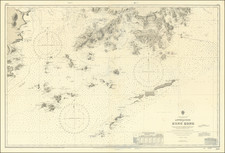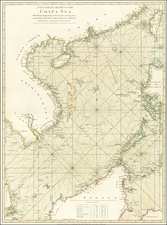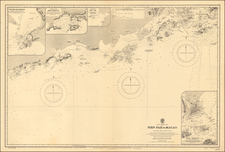Showing Japanese Concerns Regarding Soviet Troops in Manchuria. A Window into an Often-Overlooked Facet of the Japanese Occupation.
Fascinating military- or government-issued 1935 map of occupied Manchuria that shows the build-up of Soviet forces on the province's borders. While most concise pre-World War II histories of Manchuria (referred to by occupiers as "Manchukuo") suggest that Soviet and Japanese forces were more or less cooperating, this map shows that there were obvious Japanese concerns regarding Soviet forces in the mid-1930s.
The map is particularly intriguing in a number of regards. One will notice that, for a map that appears to be official, there are a number of pictorial elements. While this is not uncommon for Japanese maps in general, and draws from the long history of Japanese woodcut maps, it would be unusual to see this on a map drawn up for military purposes. As such, it would be more likely that this map was intended for the use of politicians gathering public support for the Japanese activities in Manchukuo.
These pictorial elements deserve further analysis, given their prolific nature. They paint an image of a region with a diversified economy, with an industrial coastline and an agricultural interior. Shipping lines, air routes, and railroads proliferate. Particularly interesting is the air route in the far west of the map connecting Qinhuangdao to a border city near Zabaikal'sk.
However, it is the information regarding the Soviet build-up of troops that makes this map of particular interest. This is visible in two parts, firstly in the title cartouche in the upper left that describes various subdivisions of the Russian Far East Army. It names various corps stationed in the area, including sniper regiments and armored divisions. The locations of these troops are shown with the red-shaded area and further described in the red text.
The interactions between Japanese and Russian troops before 1945 are not often discussed in histories of Manchuria, yet it is known that following the establishment of Manchukuo there was some interest among the Japanese general staff in the possible takeover of Soviet territories. This was a possibility about which Stalin was aware and concerned. However, for various reasons, a steady peace ensued, with occasional border skirmishes starting later in 1938. Yet, this tension was a constant backdrop to the existence of Manchukuo and is preserved in rare documents such as the present.
Rarity
The map appears to be uncommon, and we have only been able to locate one other example, although database searches for non-Latin-alphabet maps are less reliable.













![Генеральный Штаб Шанхай [Soviet Map of Shanghai & Environs]](https://storage.googleapis.com/raremaps/img/small/62897.jpg)
![(Second World War) Der Grossasiatisch-Amerikanische Raum [The Great Asiatic-American Space]](https://storage.googleapis.com/raremaps/img/small/88834.jpg)